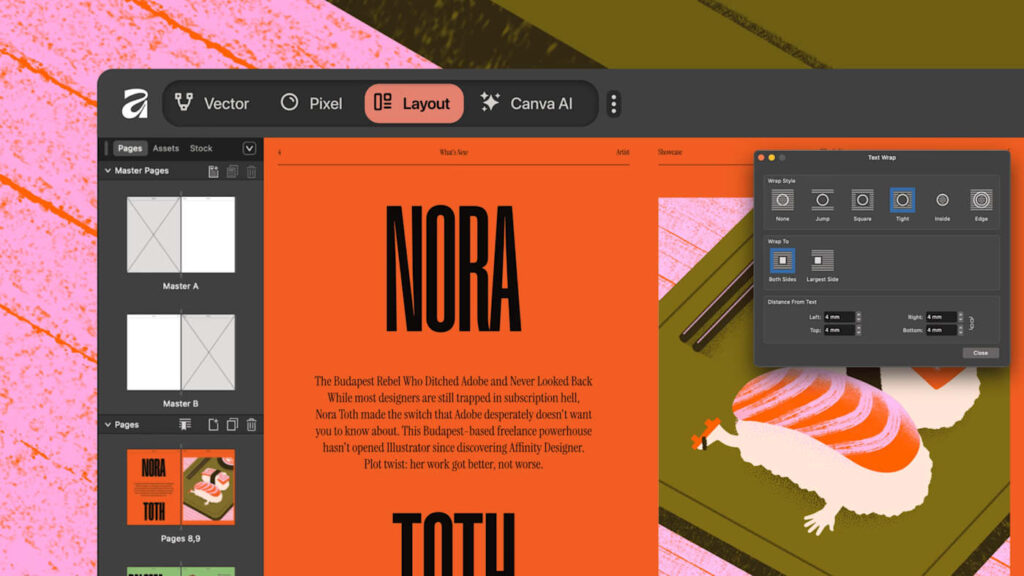Affinity: The Creative Powerhouse Reimagined as a Unified Force
Remember the days of bouncing between different apps for illustration, photo editing, and page layout? Those days might just be numbered. Affinity, the suite of professional creative tools known for its powerful features and one-time purchase model, has been reimagined. While the initial acquisition by Canva raised eyebrows, the resulting update promises a more integrated and streamlined workflow for creatives everywhere. This isn’t just a new version; it’s a creative ecosystem designed to compete directly with subscription-based giants.
A Unified Creative Experience: Affinity’s All-in-One Approach
Affinity has historically consisted of three separate applications: Designer, Photo, and Publisher. Each program offered a robust set of features tailored to its specific domain. Now, these programs are more tightly integrated than ever before. Think of it as a single application with distinct “personas” dedicated to different creative tasks.
The Persona Paradigm Shift
This new approach offers seamless transitions between vector design, raster editing, and page layout within the same project file. No more tedious exporting and importing! Imagine creating a logo in Designer, quickly retouching a product photo in Photo, and then laying out a marketing brochure in Publisher, all without leaving the Affinity environment. This saves significant time and eliminates the frustration of managing multiple files and application interfaces. The implications for creative workflows are substantial.
What Does This Mean for Users?
This unified approach simplifies the creative process significantly. For example, you can now seamlessly integrate raster images into your vector designs in Designer, or directly edit vector graphics within your Publisher layouts. This level of integration streamlines complex projects, allowing for a more fluid and intuitive creative experience. It also reduces the need for extensive training on multiple software packages, empowering creatives to focus on their art rather than wrestling with technology.
Core Strengths Remain: Power and Performance
While the integration is a significant change, Affinity remains committed to its core strengths: performance and a robust feature set. Each “persona” within the unified application retains the powerful tools and capabilities that made the individual apps so popular. This means you still get the precision vector tools of Designer, the advanced photo editing capabilities of Photo, and the professional layout features of Publisher.
Unmatched Power for Creative Professionals
Affinity continues to offer features that rival, and in some cases surpass, those found in industry-standard software. Features like non-destructive editing, advanced color management, and support for various file formats remain intact. The focus is still on providing professional-grade tools without the burden of a subscription model. This is particularly appealing to freelancers, small businesses, and hobbyists who are looking for a powerful and affordable alternative to subscription-based software.
Performance Under the Hood
Affinity has always been praised for its smooth performance and responsiveness. The developers have continued to optimize the application for both macOS and Windows, ensuring a fluid and lag-free creative experience, even when working with complex projects. This commitment to performance sets it apart from other creative software that can often feel sluggish or resource-intensive.
The Canva Connection: What Does the Future Hold?
The acquisition of Serif by Canva initially sparked concerns within the Affinity community. Would Canva abandon the one-time purchase model? Would the software become simplified or watered down? Thankfully, Canva has affirmed its commitment to maintaining Affinity as a professional-grade tool and retaining its one-time purchase option.
Synergy and Future Development
Instead of stifling Affinity, the acquisition by Canva seems to be aimed at leveraging the strengths of both platforms. Canva’s user-friendly interface and vast library of templates could potentially be integrated into the Affinity ecosystem, providing users with even more resources and inspiration. The future likely holds a blend of Affinity’s professional capabilities and Canva’s accessibility.
Staying True to Its Roots
The developers have been actively engaging with the Affinity community, listening to feedback and incorporating suggestions into the new unified application. This demonstrates a commitment to preserving the values that made Affinity so popular in the first place. It also signals a desire to continue evolving the software in a way that benefits its users.
Is Affinity Right for You?
With its powerful features, unified workflow, and subscription-free model, Affinity is a compelling option for creatives of all levels. Whether you’re a seasoned professional or just starting your creative journey, Affinity offers a comprehensive and affordable alternative to traditional subscription-based software.
Consider Your Workflow
If you frequently work across multiple creative disciplines, such as illustration, photo editing, and page layout, Affinity’s unified approach could significantly streamline your workflow. The ability to seamlessly switch between “personas” within a single application can save you time and effort. The one-time purchase is also extremely attractive, as it can save hundreds of dollars per year compared to subscriptions.
Embrace the Creative Freedom
Affinity empowers you to create without limitations. Its robust feature set, smooth performance, and subscription-free model provide the freedom and flexibility you need to bring your creative visions to life. The resurfacing of Affinity as an all-in-one application marks a new era for this creative powerhouse, and it’s one that every creative should be paying attention to.
